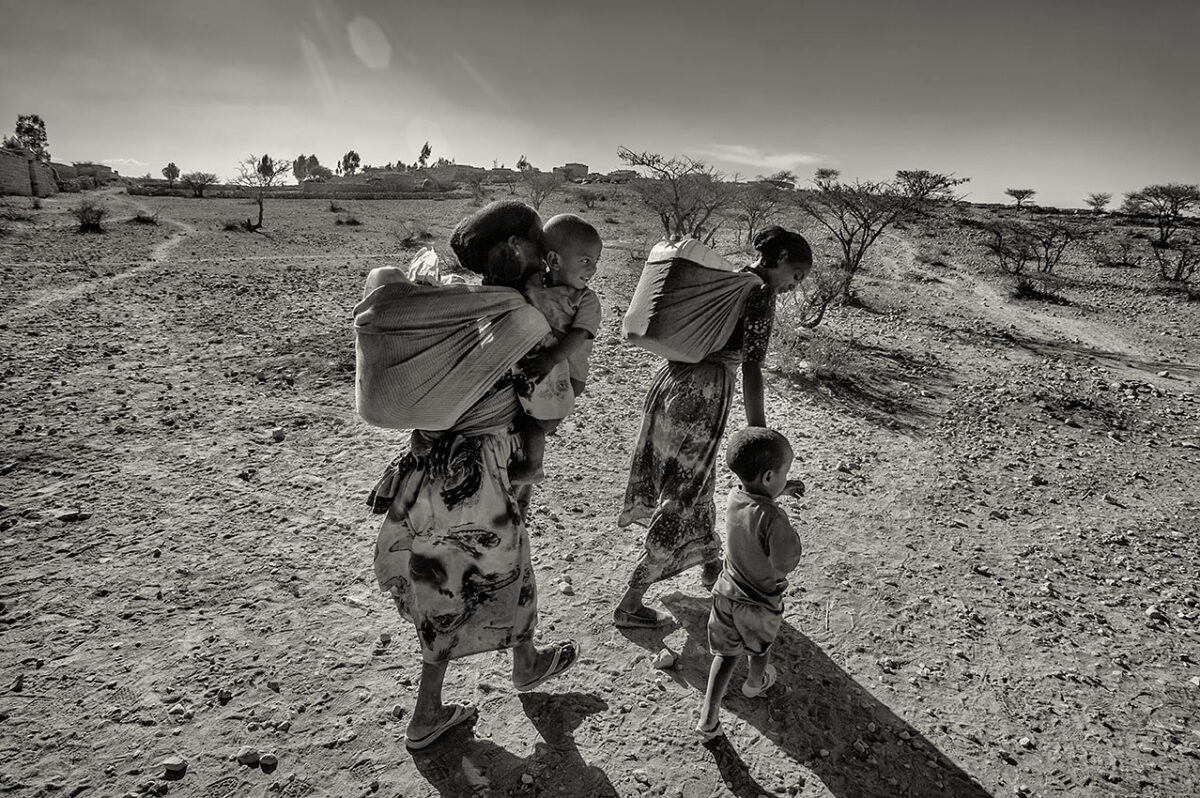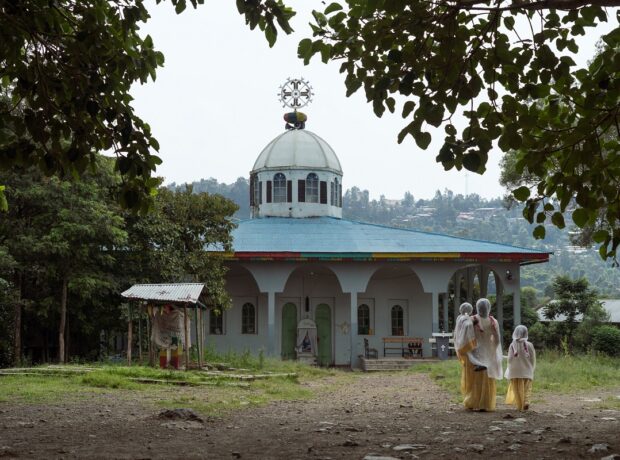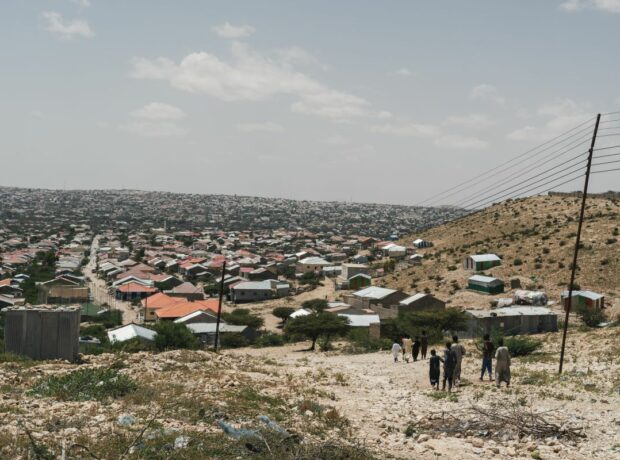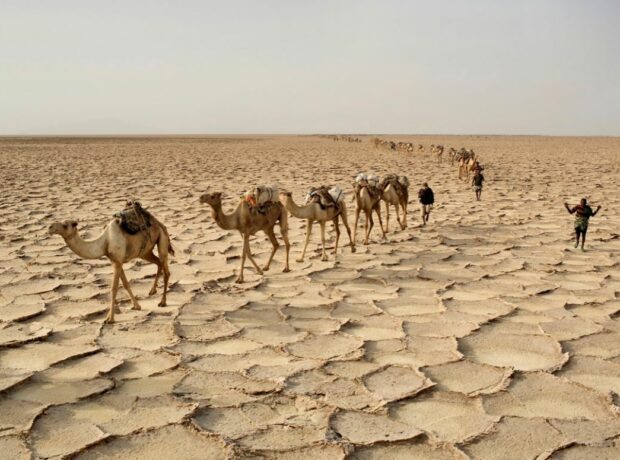Ethiopia is experiencing the most severe drought of the last half century. This reality is having a huge negative impact on the lives of women and girls responsible for fetching water for their family homes. Photojournalist Ángel López Soto and journalist Eva Mateo Asolas report on the human cost of the drought for women in Ethiopia, in Pictures and in Words.
In Ethiopia, the second most populous country in Africa and the only one that has never been colonized, 40 million women and young girls face the most acute drought of the last half century. It is their responsibility to ensure water reaches homes.
Milkina (18 months). 8.5 kilos. Moderate Malnutrition. Weight: 30% less than the average weight for her age.
Nurse Freweini Yigzam writes notes in her notebook with a serious expression. It is 11am – the fifth hour of the day in Ethiopia where time begins at dawn – and the sun is at its peak. In the small nutrition unit at Wukro’s Health Centre, in the region of Tigray, twenty mothers are waiting for their appointments. As with Milkina, their children’s first year of life has passed during Ethiopia’s worst drought in 50 years.
“Mothers don’t have enough breast milk or have very low-quality milk. We give them a nutritional supplement because both they and their children arrive here with diarrhoea, anaemia or skin illnesses because of a lack of hygiene. If it doesn’t rain the situation will get worse”, explains Freweini before Tsega’s jet-black gaze. Tsega is 28 years old. Her daughter Milkina is only one of the more than two-and-a-half-million women and children with malnutrition following the last cyclical drought in this country located in the horn of Africa. But unlike the terrible famine of 1984 – which placed Ethiopia at the epicentre of the world’s poverty – current political stability, double-digit GDP growth in the last decade, and the government’s swift response in coordination with humanitarian organisations, have contained this emergency. It has therefore gone largely unnoticed in the West.
But with the loss of 2015’s two main harvests and the results of the erratic and insufficient rains of the spring yet to be seen, the El Niño phenomenon has left over 10 million people in Ethiopia without water, food or cattle. This has had a particular impact on the female population; according to a recent survey on Health and Demography, women and young girls in Ethiopia are responsible for 86% of all the water that is brought to homes. Only 2 out of 10 rural households have running water and almost half of them are supplied by fountains and public wells.
Women and young girls in Ethiopia are responsible for 86% of all the water that is brought to homes
This explains the slow and ceaseless pilgrimage with jerricans over the rocky roads of every rural community. Women and young girls in search of water – less often little boys, almost never a man – carry on their backs these yellow buckets that can hold between 20 and 25 litres. On Saturdays, which is market day in many communities, long lines of animals carrying food for sale mingle with children, men and women as the dust is kicked up around them. The extreme drought they have endured for the entire year continues to result in ever-increasing distances required to travel.
Yeshitu Fantu is one of the water-pilgrims. She is accompanied by two of her five children standing in the queue next to the school at Awchara. Ayuda en Acción has installed a depot here in order to help provide water to 70,000 people.
“Today fewer people came because it rained one day, but I’m afraid that it won’t rain again for a long time”, says Yeshitu, as she fills the two jerricans she is allowed to fill every day.
Women across the world spend 200 million hours a day in collecting water, almost a third of their working day. For Yeshitu, to have a water distribution point nearby has spared her from walking three hours from her house while carrying heavy buckets. This makes a difference between having or not having time to continue studying or taking care of activities that can generate income for the family. In Ethiopia, women usually do not have a paid job, in spite of the fact that they represent almost half of the work force in the country, especially in the countryside, where it is common to see mothers and daughters taking care of animals, carrying wood or planting teff, a millenary cereal considered a ‘superfood’ used to cook injera, an unleavened bread that constitutes the basis of their diet.
In the words of the women in charge of the water committee in the rural kebele of Mekane Birhan, “water is a women’s problem”. For Ashageru, forty-years-old and a mother of three children, the administration has become a challenge. Five years ago she was elected by the community to manage the water distribution. Each day she supervises the supply and makes sure that families have access to this precious resource provided by one public fountain, around which hundreds of people crowd. Each person pays the equivalent of €0.1 for a twenty-litre bucket, 600 times less than the market price of bottled water. Aguadora (water-suppliers), like Ashageru or Yeshitu, have become centrepieces of this invisible crisis. However, water does not belong to them. In order to overcome water scarcity, women and young girls in Ethiopia often sacrifice their own consumption in favour of male members of the family.
Why do Ethiopian women, who are always the last to drink, have the responsibility for accessing water placed in their hands? “Women in Ethiopia are the first ones to suffer from problems related to the lack of water and the difficulties in accessing it. Usually, women are in charge of getting water for the family because it is considered their job, as water is used for basic household chores, such as preparing food, washing clothes, cleaning the house, taking care of the family’s hygiene, providing water for the animals, etc. It makes sense that they manage the water”, answers Olatz Ecenarro, the woman in charge of Ayuda en Acción’s emergency area.
The NGO has put women in control of its projects involving the management of this natural resource in Ethiopia. Water projects are between six and eight times more effective when women are in charge. According to FAO, women with the same access to productive sources as men (including water), can increase the efficiency of farms by 20-30% and save 150 million people from starvation. One of the Ethiopian government’s most ambitious reforms in the last decade has been the Land Certification Law, which allows women to share the ownership of the land with their husbands in equal measure. The Law also allows women to keep their share of land in case of divorce and to inherit it in the event of becoming a widow or following the death of their parents. There is a double objective: to tackle poverty and promote gender equality.
The lack of seeds is jeopardising the next harvest and could worsen the food insecurity
Nonetheless, the drought has left many of those lands unprepared. With the planting season ahead, the lack of seeds is jeopardising the next harvest and it could worsen the problem of food insecurity. The 171 members of the savings and loan union SACCO in Mekane Birhan know the problem very well. Marelign Ademe applied for a loan of 2,500 Birr (€109) some years ago in order to buy a sheep; today she has 12 of them, which represent the main income of the family. With that, she could send her two daughters to school, a significant achievement in a country where half of the women in rural areas do not complete school.
However, because of the drought, nine members of the union could not pay the loan with which they had bought seeds. They are the women who were born during the 1980s famine and now walk with their daughters again in search of water. Some things have not changed.
Translations by Sofía Mercader (Warwick University). Banner photo by Ángel López Soto.



